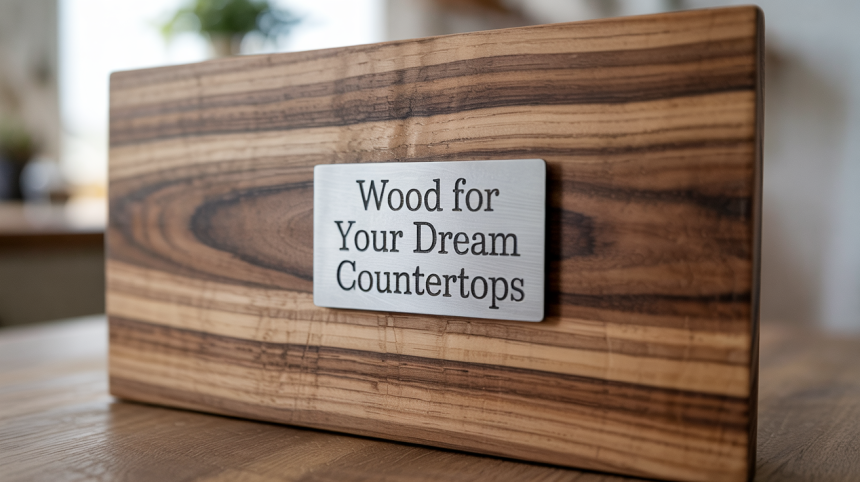Wood countertops add warmth and character to any kitchen. But which type will work best for your home? Many homeowners feel lost when choosing between oak, maple, walnut, and other options.
The right wood can make your kitchen stand out while meeting your daily needs. Each type offers different benefits – some resist water better, others show fewer knife marks, and many age with a rich look over time.
This guide walks you through the top wood choices for countertops. You’ll learn about durability, maintenance, cost, and appearance of each option. We tested these woods in real kitchens to bring you honest feedback.
Ready to find the perfect wood for your kitchen countertops? Let’s look at what makes each option special.
Benefits of Wood Countertops
Wood countertops bring natural warmth to kitchens that other materials can’t match. The rich tones and grain patterns create a welcoming feel that makes your kitchen the heart of your home.
When properly maintained, wood countertops last for years. They can be:
- Sanded and refinished multiple times to remove scratches and stains
- Made from trees grown in managed forests for environmental friendliness
- Softer on dishes, causing fewer breaks when items are dropped
Wood adapts to your design vision with ease. You can choose from light maple, mid-toned cherry, or dark walnut to match your style. The finish can be changed from matte to glossy based on your taste. Plus, wood countertops can be cut and shaped to fit any kitchen layout.
Top 7 Best Woods for Countertops
Looking for the ideal wood for your kitchen countertops? These seven options offer beauty and function to suit different needs and budgets.
1. Maple
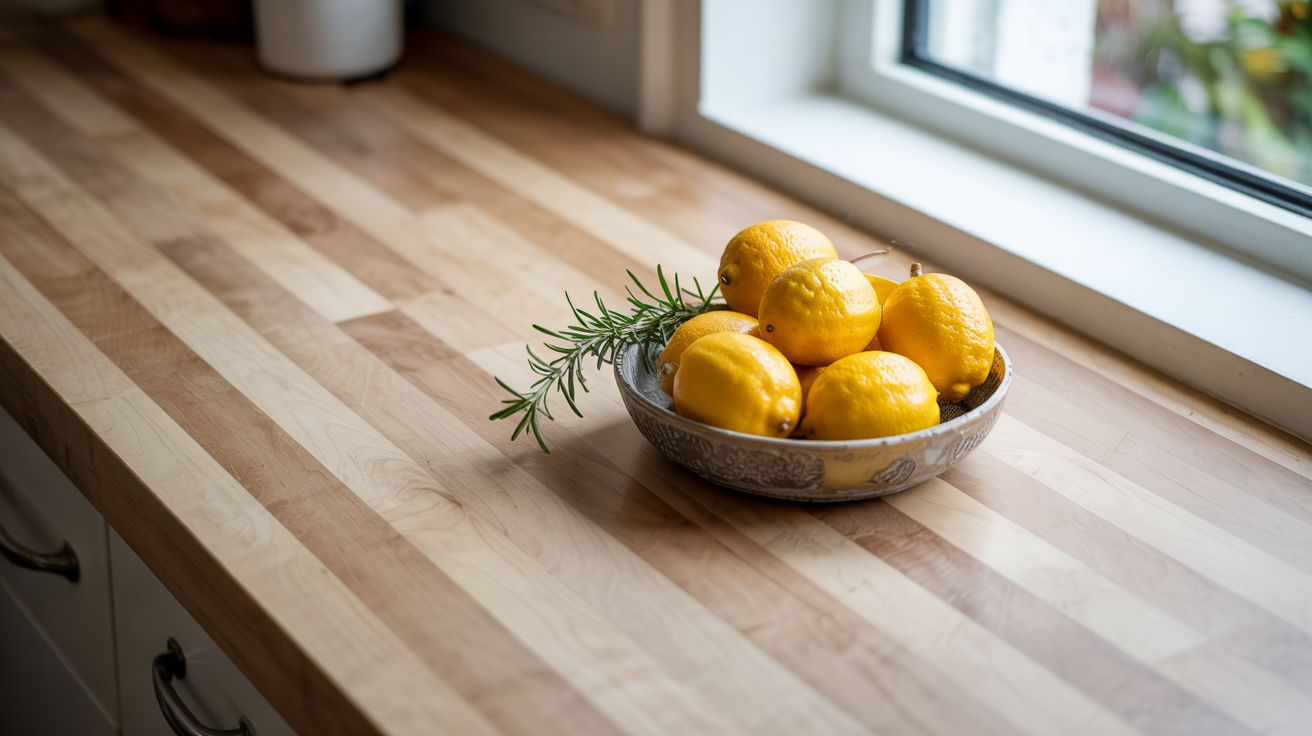
Maple provides a clean, bright look with subtle grain patterns. It ranks high on hardness tests, making it tough enough for busy kitchens where cooking happens daily.
Pros and Cons of Maple Wood:
| Pros | Cons |
|---|---|
| Very hard and durable | Requires regular sealing |
| Light color brightens kitchens | Shows stains if not sealed properly |
| Takes stains well if you want color | Less distinctive grain than other woods |
What makes it special: Maple’s tight, closed grain makes it more water-resistant than many other hardwoods when properly sealed.
2. Walnut
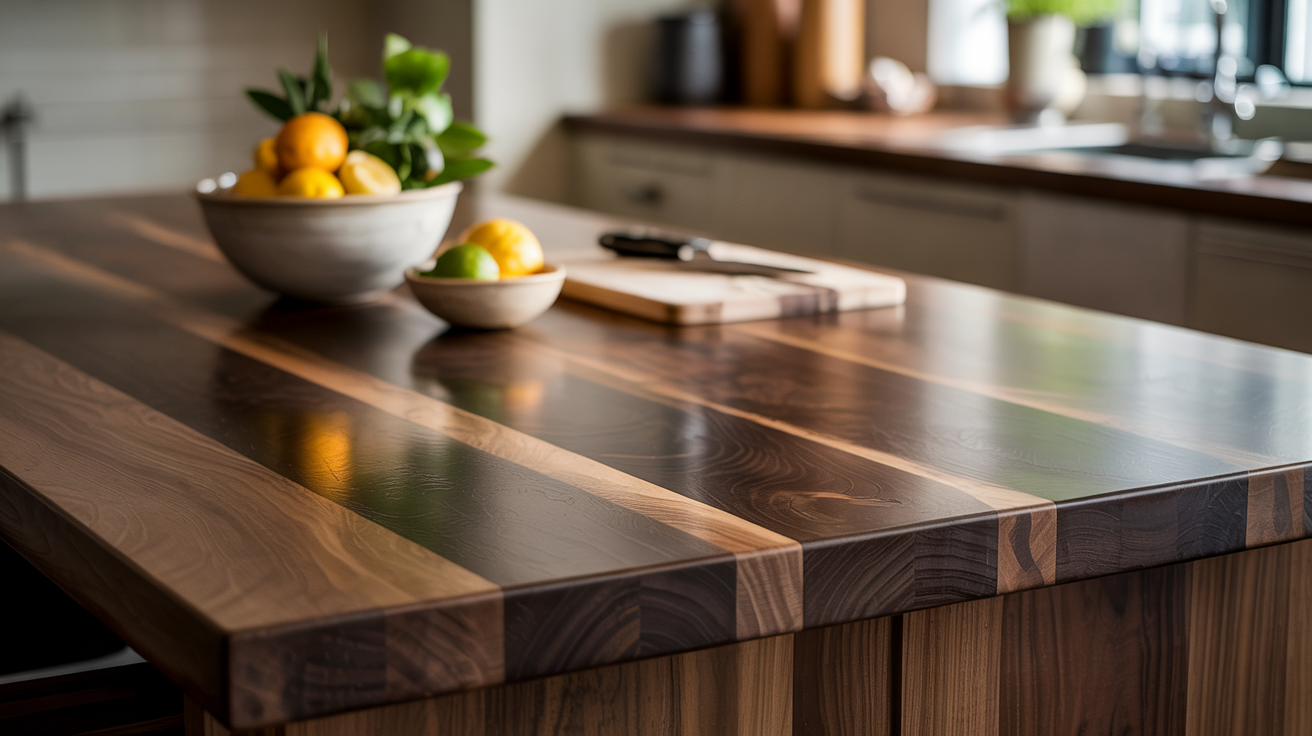
Walnut stands out with its deep, chocolate-brown tones. This wood brings a sense of luxury to any kitchen while still being practical for daily use.
Pros and Cons of Walnut Wood:
| Pros | Cons |
|---|---|
| Rich, dark color | Higher cost than other options |
| Hides small scratches well | Needs periodic refinishing |
| Strong and stable | Can fade in direct sunlight |
What makes it special: Walnut darkens and improves with age, unlike many woods that lighten over time.
3. Cherry
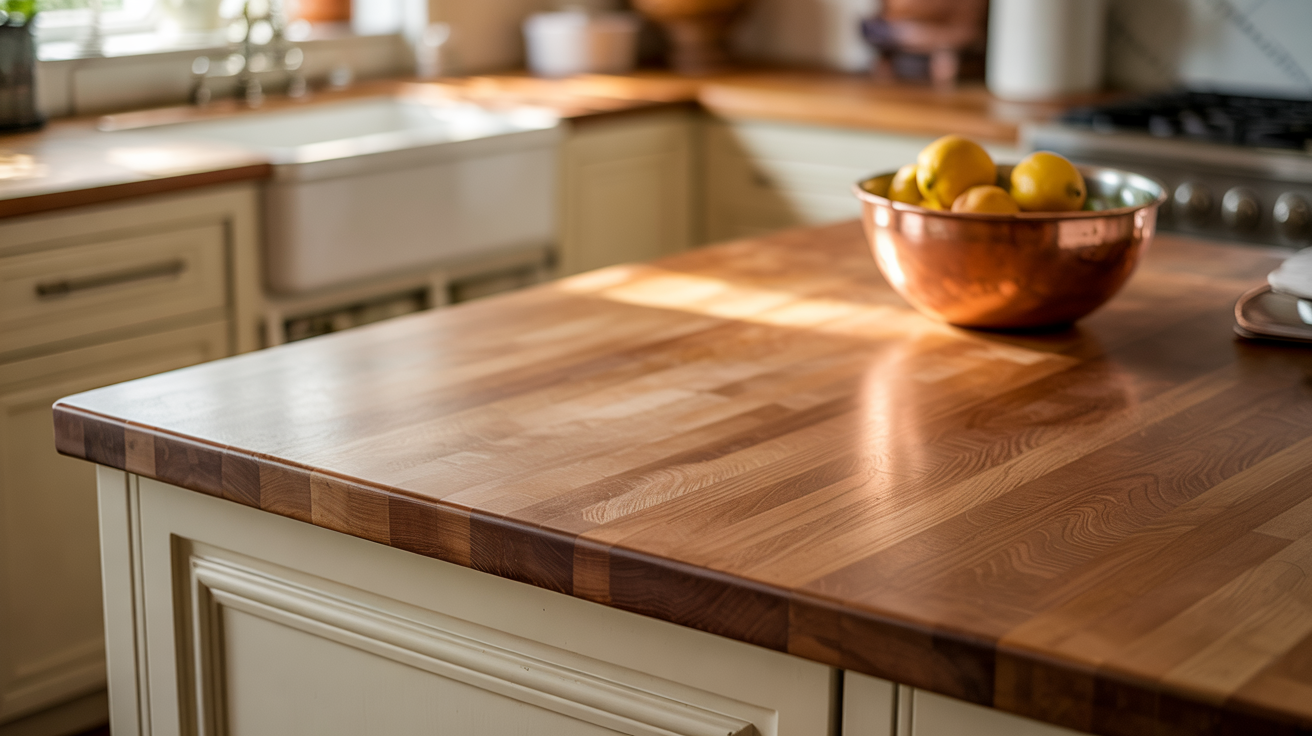
Cherry wood offers a warm, reddish-brown color that gets better with time. It has a smooth, fine grain that feels pleasant to touch.
Pros and Cons of Cherry Wood:
| Pros | Cons |
|---|---|
| Warm color that deepens with age | Softer wood that can dent |
| Fine, straight grain pattern | Scratches more easily than maple |
| Ages beautifully | Needs UV protection to prevent uneven darkening |
What makes it special: Cherry develops a rich patina over years that many homeowners find worth the extra care it requires.
4. Oak
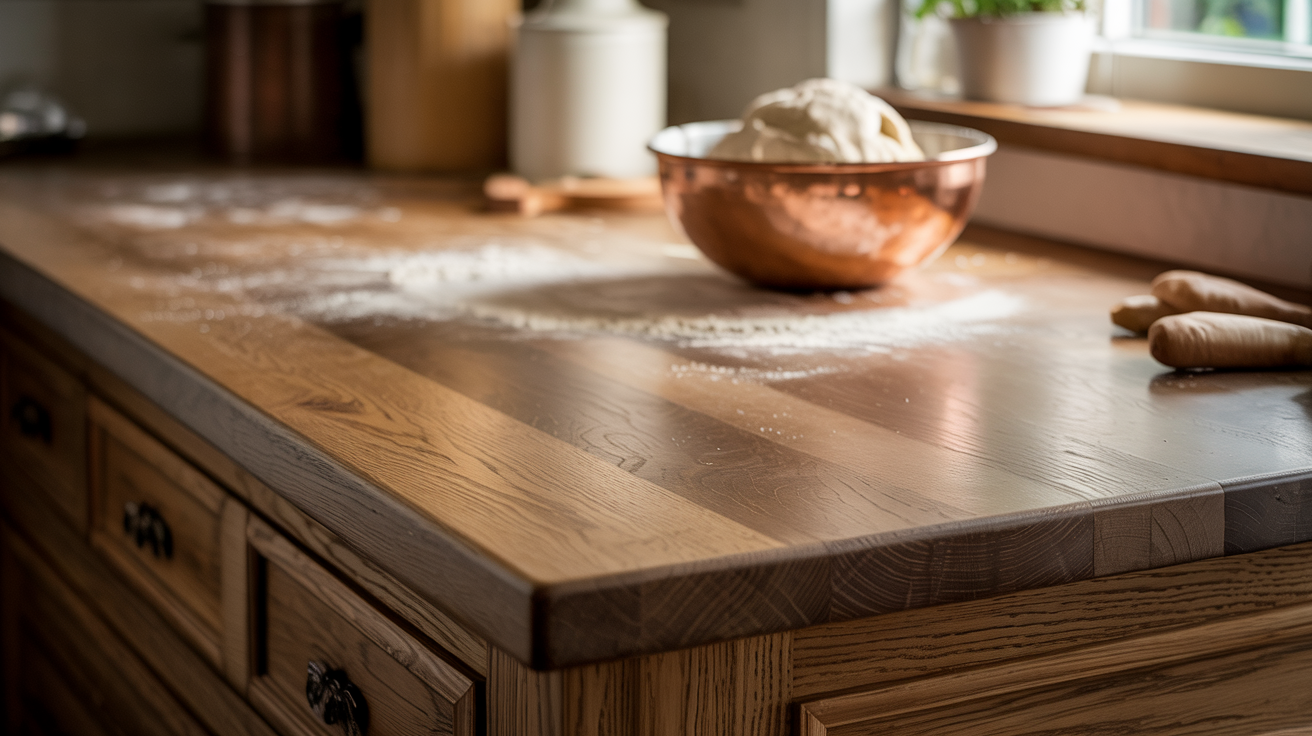
Oak brings classic appeal with its strong grain patterns. It remains one of the most common woods used in American homes for its strength and availability.
Pros and Cons of Oak Wood:
| Pros | Cons |
|---|---|
| Very strong and durable | Grain can be porous |
| Widely available | Requires thorough sealing |
| Distinctive grain adds character | Can have an “old-fashioned” look |
What makes it special: Oak’s open grain creates a textured look that many find adds depth and interest to kitchen design.
5. Teak
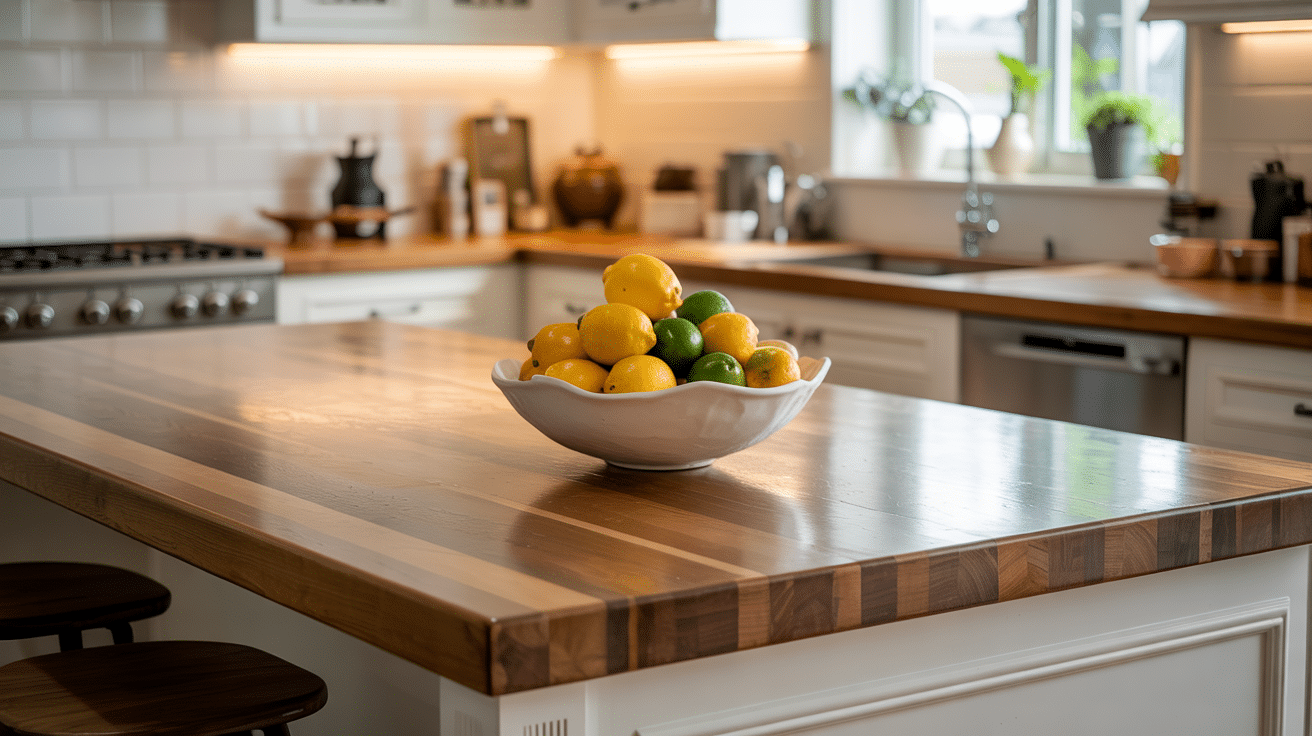
Teak contains natural oils that make it perfect for kitchen use. This tropical wood handles moisture better than most other options.
Pros and Cons of Teak Wood:
| Pros | Cons |
|---|---|
| Natural water resistance | More expensive than domestic woods |
| Needs less sealing than other woods | Limited supply raises ethical concerns |
| Very stable with little warping | Requires occasional oiling |
What makes it special: Teak has been used in shipbuilding for centuries due to its water resistance—making it ideal for wet kitchen areas.
6. Bamboo
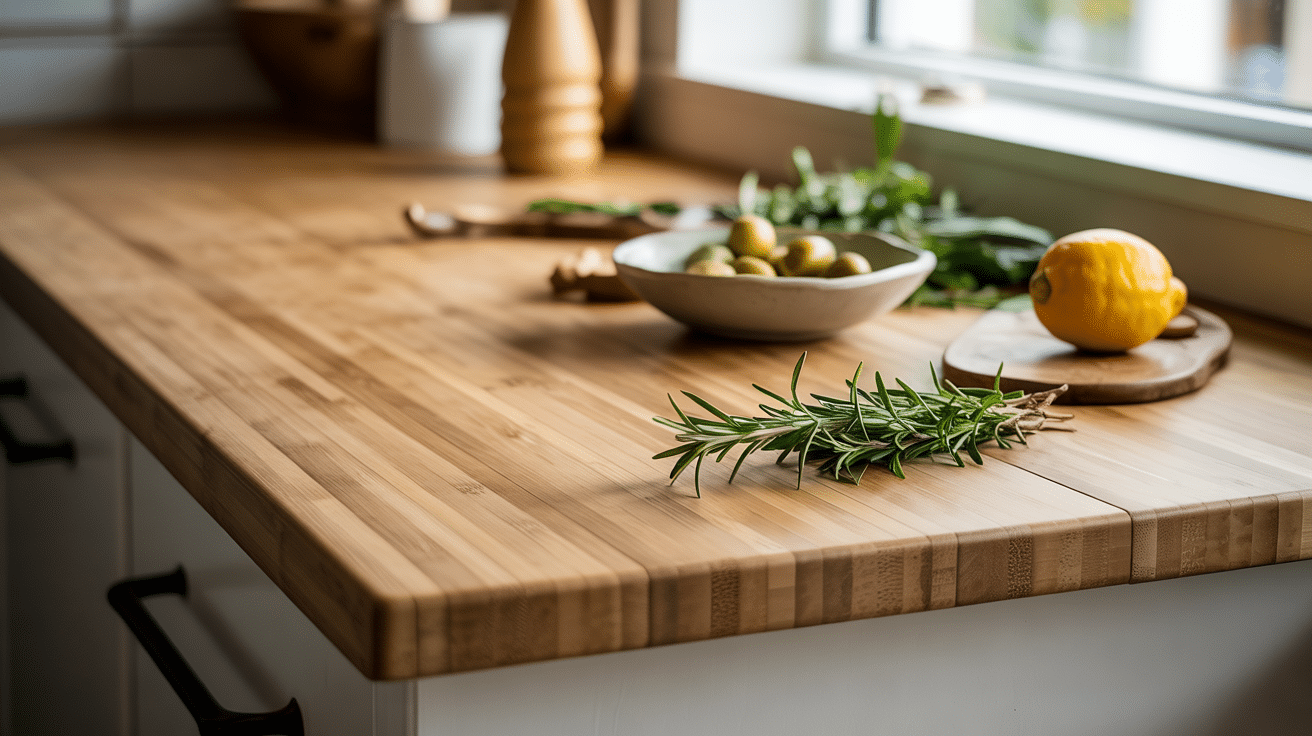
Bamboo offers an eco-friendly option that grows much faster than hardwood trees. It creates a modern look with its distinctive grain pattern.
Pros and Cons of Bamboo Wood:
| Pros | Cons |
|---|---|
| Fast-growing and sustainable | Shows scratches more readily |
| Hard surface comparable to maple | Requires frequent sealing |
| More affordable than many hardwoods | Limited color options |
What makes it special: Bamboo is technically a grass, making it the fastest-renewing option on this list—ready for harvest in just 3-5 years.
7. Acacia
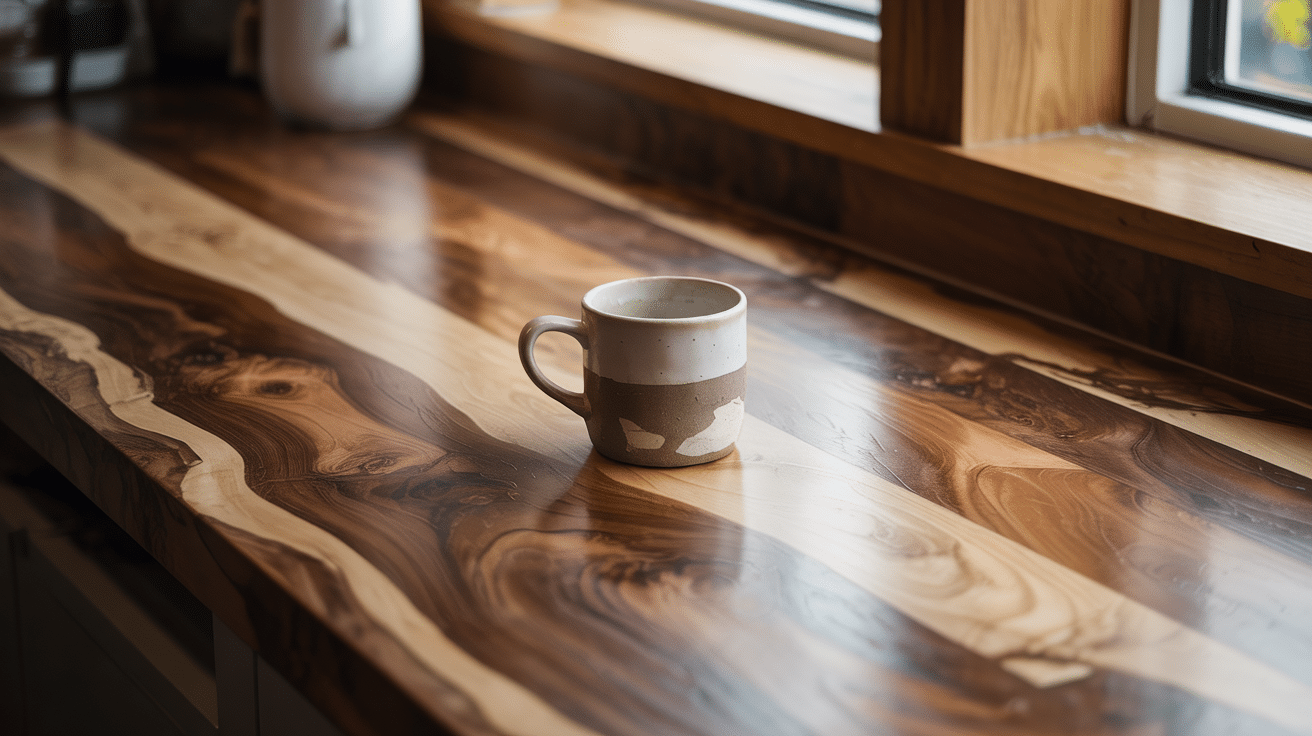
Acacia presents stunning grain patterns with varying color tones. This wood brings visual interest to any kitchen design at a reasonable price point.
Pros and Cons of Acacia Wood:
| Pros | Cons |
|---|---|
| Beautiful grain with color variation | Inconsistent hardness across the board |
| Good water resistance | Regular maintenance needed |
| More affordable than walnut or teak | Can be prone to movement with humidity |
What makes it special: Acacia’s dramatic grain patterns and color variations make each countertop truly one-of-a-kind.
Key Factors to Consider When Choosing Wood
1. Hardness and durability: The Janka hardness scale rates woods by resistance to dents and wear. Harder woods like maple (1450) and bamboo (1380) suit busy kitchens, while softer woods like cherry (950) work better in less active areas.
2. Grain pattern and aesthetics: Wood grain affects both look and function. Closed-grain woods like maple have tiny pores that resist bacteria and moisture. Open-grain woods like oak offer more texture but require more thorough sealing to prevent food particles from lodging in pores.
3. Maintenance and care requirements: Some woods need monthly oiling, others need yearly resealing. Teak contains natural oils requiring less frequent treatment. Maple needs regular sealing to maintain its water resistance. Consider your willingness to perform upkeep tasks.
4. Cost and budget considerations: Prices range widely from $40-$200 per square foot installed. Domestic woods like oak and maple cost less than imported exotic woods like teak. Factor in installation costs, which can add $15-$30 per square foot to your total.
5. Water resistance: Kitchen countertops face spills daily. Woods with natural oils like teak and walnut handle moisture better than others. All wood countertops need proper sealing, but some woods naturally resist water damage better, reducing long-term maintenance needs.
Comparison Table of Wood Types
Below is a visual comparison of the main wood types for countertops to help you quickly assess your options:
| Wood Type | Hardness (Janka Scale) | Price Range (per sq ft) | Maintenance Level | Best Uses |
|---|---|---|---|---|
| Maple | 1450 | $40-$75 | Medium | High-traffic kitchens, baking areas |
| Walnut | 1010 | $85-$150 | Medium-High | Islands, statement pieces, modern kitchens |
| Cherry | 950 | $70-$120 | High | Low-traffic areas, formal kitchens |
| Oak | 1290 | $45-$85 | Medium-High | Traditional kitchens, rustic designs |
| Teak | 1155 | $100-$200 | Low-Medium | Near sinks, wet areas, outdoor kitchens |
| Bamboo | 1380 | $40-$90 | Medium | Eco-friendly homes, modern designs |
| Acacia | 1750 | $60-$100 | Medium | Statement pieces, varied color needs |
Conclusion
Wood countertops offer a mix of beauty and function that few other materials can match. The right choice depends on your specific needs, style, and how much upkeep you’re willing to do.
For busy family kitchens, harder woods like maple or acacia will serve you well. If looks matter most, walnut and cherry bring rich color that gets better with time. Those concerned about water damage should look to teak with its natural oils.
Remember that all wood countertops need some care. The extra attention pays off with surfaces that age well and last for years.
Which wood suits your kitchen best? Consider the charts and tips we’ve shared, then choose the option that fits your cooking style, budget, and design vision.
What wood are you leaning toward for your kitchen?
Frequently Asked Questions
1. What Is the Most Durable Wood Countertop Finish?
Food-grade mineral oil topped with beeswax offers excellent durability. Polyurethane and epoxy finishes last longer but create a plastic-like surface that can’t be easily repaired.
2. Are Wood Countertops a Good Idea?
Yes, for those who value warmth and natural beauty. They require more care than stone or laminate but offer unique character and can be fully restored when damaged.
3. What Is the Hardest Wood for Kitchen Countertops?
Acacia ranks highest at 1750 on the Janka scale among common countertop woods. Maple (1450) and bamboo (1380) follow as excellent hard options for busy kitchens.

